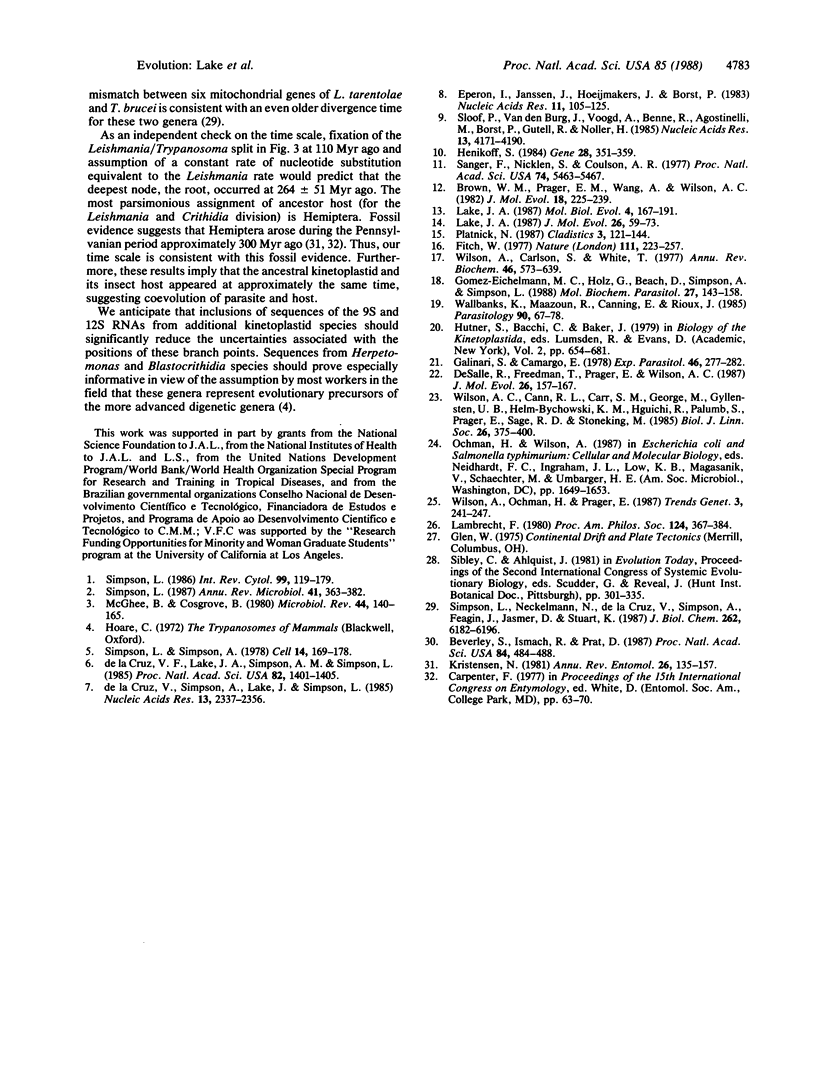Abstract
A phylogenetic tree for the evolution of five representative species from four genera of kinetoplastid protozoa was constructed from comparison of the mitochondrial 9S and 12S rRNA gene sequences and application of both parsimony and evolutionary parsimony algorithms. In the rooted version of the tree, the monogenetic species Crithidia fasciculata is the most deeply rooted, followed by another monogenetic species, Leptomonas sp. The three digenetic species Trypanosoma cruzi, Trypanosoma brucei, and Leishmania tarentolae branch from the Leptomonas line. The substitution rates for the T. brucei and T. cruzi sequences were 3-4 times greater than that of the L. tarentolae sequences. This phylogenetic tree is consistent with our cladistic analysis of the biological evidence including life cycles for these five species. A tentative time scale can be assigned to the nodes of this tree by assuming that the common ancestor of the digenetic parasites predated the separation of South America and Africa and postdated the first fossil appearance of its host (inferred by parsimony analysis). This time scale predicts that the deepest node occurred at 264 +/- 51 million years ago, at a time commensurate with the fossil origins of the Hemiptera insect host. This implies that the ancestral kinetoplastid and its insect host appeared at approximately the same time. The molecular data suggest that these eukaryotic parasites have an evolutionary history that extends back to the origin of their insect host.
Full text
PDF




Selected References
These references are in PubMed. This may not be the complete list of references from this article.
- Beverley S. M., Ismach R. B., Pratt D. M. Evolution of the genus Leishmania as revealed by comparisons of nuclear DNA restriction fragment patterns. Proc Natl Acad Sci U S A. 1987 Jan;84(2):484–488. doi: 10.1073/pnas.84.2.484. [DOI] [PMC free article] [PubMed] [Google Scholar]
- Brown W. M., Prager E. M., Wang A., Wilson A. C. Mitochondrial DNA sequences of primates: tempo and mode of evolution. J Mol Evol. 1982;18(4):225–239. doi: 10.1007/BF01734101. [DOI] [PubMed] [Google Scholar]
- DeSalle R., Freedman T., Prager E. M., Wilson A. C. Tempo and mode of sequence evolution in mitochondrial DNA of Hawaiian Drosophila. J Mol Evol. 1987;26(1-2):157–164. doi: 10.1007/BF02111289. [DOI] [PubMed] [Google Scholar]
- Eperon I. C., Janssen J. W., Hoeijmakers J. H., Borst P. The major transcripts of the kinetoplast DNA of Trypanosoma brucei are very small ribosomal RNAs. Nucleic Acids Res. 1983 Jan 11;11(1):105–125. doi: 10.1093/nar/11.1.105. [DOI] [PMC free article] [PubMed] [Google Scholar]
- Galinari S., Camargo E. P. Trypanosomatid protozoa: survey of acetylornithinase and ornithine acetyltransferase. Exp Parasitol. 1978 Dec;46(2):277–282. doi: 10.1016/0014-4894(78)90141-8. [DOI] [PubMed] [Google Scholar]
- Gomez-Eichelmann M. C., Holz G., Jr, Beach D., Simpson A. M., Simpson L. Comparison of several lizard Leishmania species and strains in terms of kinetoplast minicircle and maxicircle DNA sequences, nuclear chromosomes, and membrane lipids. Mol Biochem Parasitol. 1988 Jan 15;27(2-3):143–158. doi: 10.1016/0166-6851(88)90034-5. [DOI] [PubMed] [Google Scholar]
- Henikoff S. Unidirectional digestion with exonuclease III creates targeted breakpoints for DNA sequencing. Gene. 1984 Jun;28(3):351–359. doi: 10.1016/0378-1119(84)90153-7. [DOI] [PubMed] [Google Scholar]
- Lake J. A. A rate-independent technique for analysis of nucleic acid sequences: evolutionary parsimony. Mol Biol Evol. 1987 Mar;4(2):167–191. doi: 10.1093/oxfordjournals.molbev.a040433. [DOI] [PubMed] [Google Scholar]
- Lake J. A. Determining evolutionary distances from highly diverged nucleic acid sequences: operator metrics. J Mol Evol. 1987;26(1-2):59–73. doi: 10.1007/BF02111282. [DOI] [PubMed] [Google Scholar]
- Lambrecht F. L. Palaeoecology of Tsetse flies and sleeping sickness in Africa. Proc Am Philos Soc. 1980 Oct 10;124(5):367–385. [PubMed] [Google Scholar]
- McGhee R. B., Cosgrove W. B. Biology and physiology of the lower Trypanosomatidae. Microbiol Rev. 1980 Mar;44(1):140–173. doi: 10.1128/mr.44.1.140-173.1980. [DOI] [PMC free article] [PubMed] [Google Scholar]
- Sanger F., Nicklen S., Coulson A. R. DNA sequencing with chain-terminating inhibitors. Proc Natl Acad Sci U S A. 1977 Dec;74(12):5463–5467. doi: 10.1073/pnas.74.12.5463. [DOI] [PMC free article] [PubMed] [Google Scholar]
- Simpson L. Kinetoplast DNA in trypanosomid flagellates. Int Rev Cytol. 1986;99:119–179. doi: 10.1016/s0074-7696(08)61426-6. [DOI] [PubMed] [Google Scholar]
- Simpson L., Neckelmann N., de la Cruz V. F., Simpson A. M., Feagin J. E., Jasmer D. P., Stuart K. Comparison of the maxicircle (mitochondrial) genomes of Leishmania tarentolae and Trypanosoma brucei at the level of nucleotide sequence. J Biol Chem. 1987 May 5;262(13):6182–6196. [PubMed] [Google Scholar]
- Simpson L., Simpson A. G. Kinetoplast RNA of Leishmania tarentolae. Cell. 1978 May;14(1):169–178. doi: 10.1016/0092-8674(78)90311-2. [DOI] [PubMed] [Google Scholar]
- Simpson L. The mitochondrial genome of kinetoplastid protozoa: genomic organization, transcription, replication, and evolution. Annu Rev Microbiol. 1987;41:363–382. doi: 10.1146/annurev.mi.41.100187.002051. [DOI] [PubMed] [Google Scholar]
- Sloof P., Van den Burg J., Voogd A., Benne R., Agostinelli M., Borst P., Gutell R., Noller H. Further characterization of the extremely small mitochondrial ribosomal RNAs from trypanosomes: a detailed comparison of the 9S and 12S RNAs from Crithidia fasciculata and Trypanosoma brucei with rRNAs from other organisms. Nucleic Acids Res. 1985 Jun 11;13(11):4171–4190. doi: 10.1093/nar/13.11.4171. [DOI] [PMC free article] [PubMed] [Google Scholar]
- Wallbanks K. R., Maazoun R., Canning E. U., Rioux J. A. The identity of Leishmania tarentolae Wenyon 1921. Parasitology. 1985 Feb;90(Pt 1):67–78. doi: 10.1017/s0031182000049027. [DOI] [PubMed] [Google Scholar]
- Wilson A. C., Carlson S. S., White T. J. Biochemical evolution. Annu Rev Biochem. 1977;46:573–639. doi: 10.1146/annurev.bi.46.070177.003041. [DOI] [PubMed] [Google Scholar]
- de la Cruz V. F., Lake J. A., Simpson A. M., Simpson L. A minimal ribosomal RNA: sequence and secondary structure of the 9S kinetoplast ribosomal RNA from Leishmania tarentolae. Proc Natl Acad Sci U S A. 1985 Mar;82(5):1401–1405. doi: 10.1073/pnas.82.5.1401. [DOI] [PMC free article] [PubMed] [Google Scholar]
- de la Cruz V. F., Simpson A. M., Lake J. A., Simpson L. Primary sequence and partial secondary structure of the 12S kinetoplast (mitochondrial) ribosomal RNA from Leishmania tarentolae: conservation of peptidyl-transferase structural elements. Nucleic Acids Res. 1985 Apr 11;13(7):2337–2356. doi: 10.1093/nar/13.7.2337. [DOI] [PMC free article] [PubMed] [Google Scholar]


